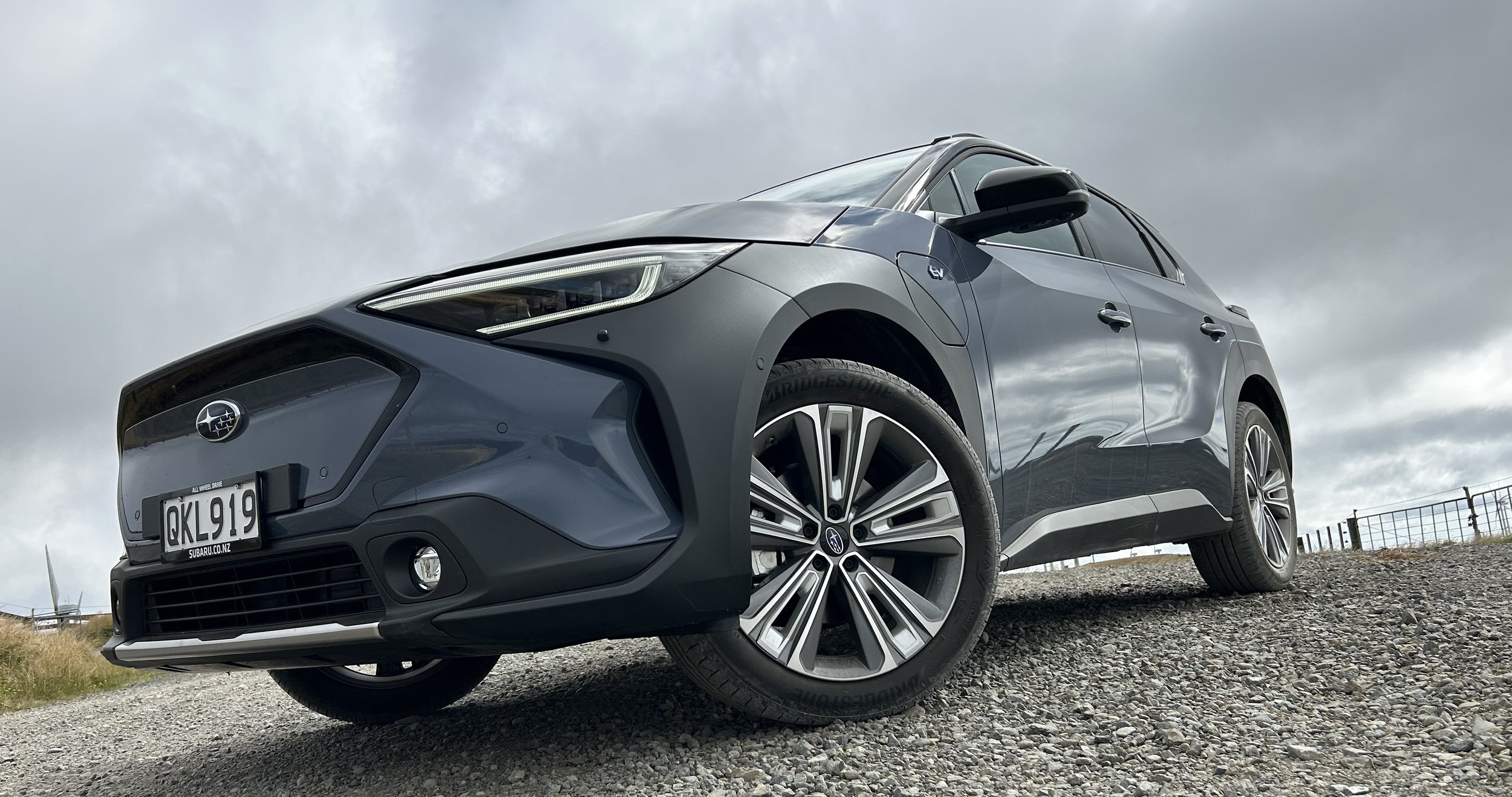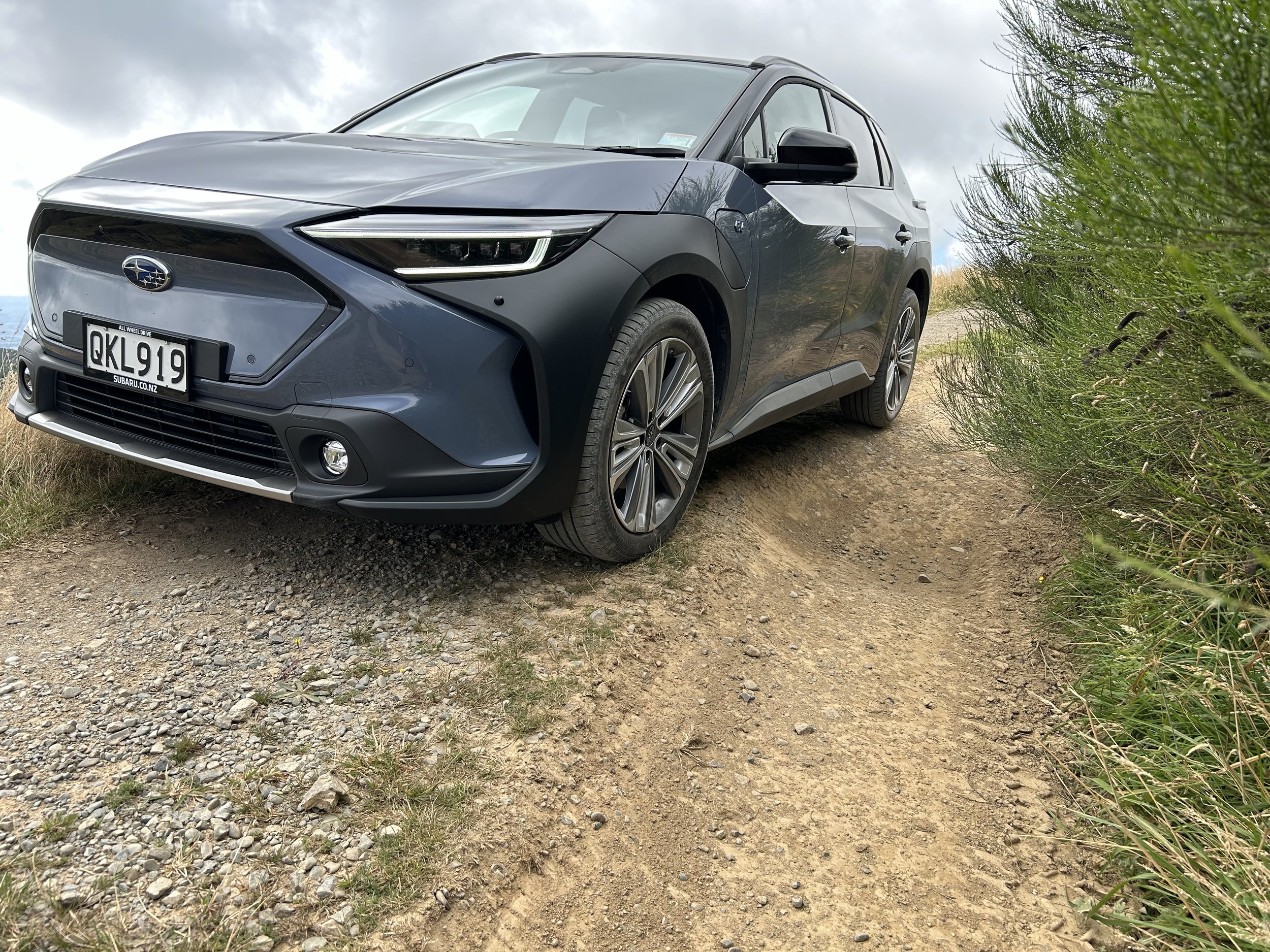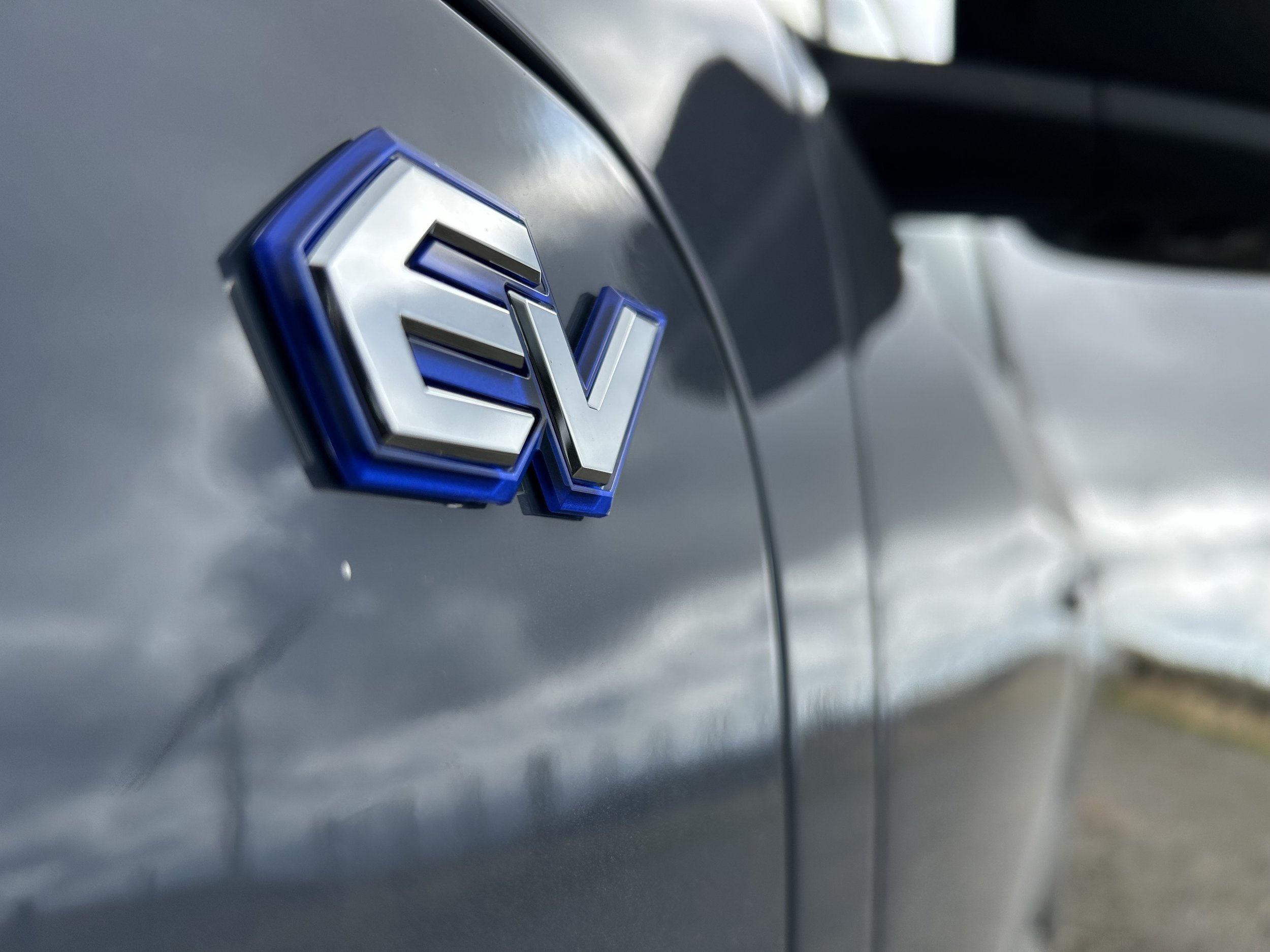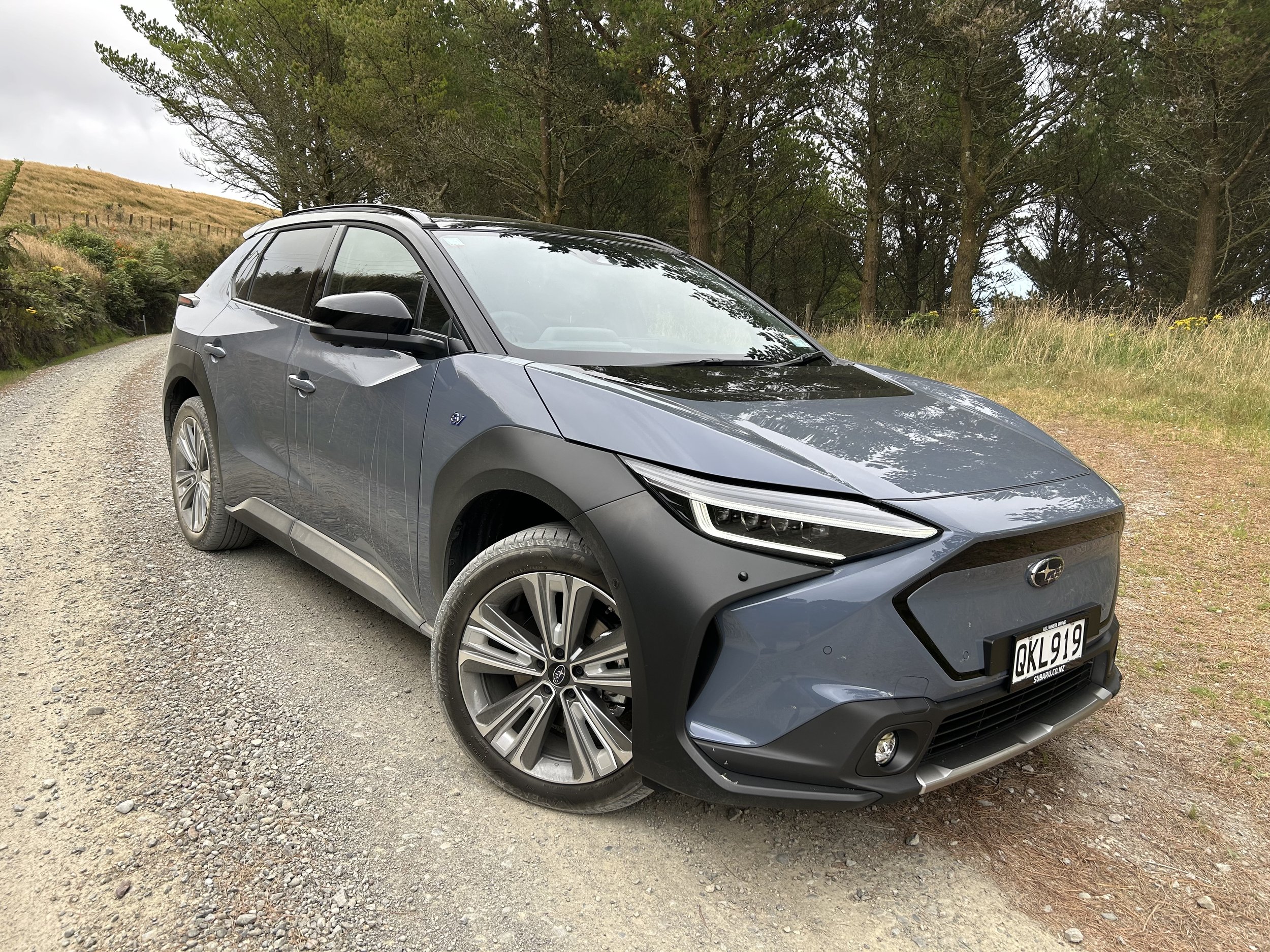Subaru Solterra Touring: Well-earthed electric adventurer
/It’s a promising step into the sustainable safari scene.
Price: $84,990.
Powertrain: Dual electro synchronous motor, 160kW/366Nm; 71.4kWh battery, single speed transmission.
How big: Length, 4690mm; width, 2180mm (with mirrors); height, 1650mm.
We like: Typically solid partner brand engineering enhanced by Subaru special touches; X-mode at its finest.
Not so much: Interior plastics; no glovebox; middling for performance and range.
GIVEN it’s largely designed, and also built, by Toyota, how much ‘Subaru-ness’ does the Solterra really have?
It’s a pertinent question. Decidedly the most left-field of all Japan’s car brands, Subaru and Toyota have collaborated before, but with the 86 small sports car; a great product but also one arguablyoutside Fuji’s zone of expertise. That programme was all about the flat four engine.
Solterra intends much more toward Subaru’s primary remit. It’s an electric version of a car Fuji does best: A sports utility wagon with off-road cojones.
Basically, then, a battery-fed next chapter from the generations of Pleiades-badged models - Crosstrek (nee XV), Forester and Outback - that have established a rock-solid reputation for delivering surprising decent ruggedness and all-terrain aptitude.
Realistically, if the Solterra isn’t up to that tradition, it’s not going to be accepted by those uber-brand fans Subaru needs to keep on board to make transition into the electric age worthwhile.
So, some positive news. As Toyota-like as the Solterra appears exterior-wise— squint and you’d think it was a RAV4 - and within the cabin (where a Subaru-chosen steering wheel and some trim aside, it’s all from Japan’s No,1, including the Prius-like push and twist Drive selector), it’s not that Toyota-like to drive in terrain Subarus traditionally like to tread.
How far into untamed topography could it ultimately be taken? From this experience, it’s still a journey into the unknown … this was a brand-new car. I was first to get the key. I didn’t want to be the first to kill one.
However, speaking as a former Outback and Forester owner, I can relate I’d have high confidence in taking the electric choice into any of the spots I drove those cars. It does okay. Really okay, actually.
That shouldn’t come as a surprise. Yes, it’s clearly a bZ4X. And Toyota clearly runs the programme and has signed a lot of cheques. Yet it’s just as evident that Subaru hasn’t allowed their car to be a badge-engineering exercise. As much as the basic drivetrain tech across both brands is the same, the smaller partner has done a lot of bespoke tweaking.
Compare specs and it’s plain that, in taking the Subaru, you have more than just extra ride height. More importantly, you get a different set of off-road tools, via Subaru’s ‘X mode’.
If you’ve tried this in any fossil-fuelled Scooby, you’ll know X marks a very specific talent spot. With the Toyota, there’s off-road functionality. But you need the Subaru for the real deal.
Knowing this, it seems astounding Solterra’s launch drive didn’t even touch gravel, let alone anything gnarly. Such a hugely missed opportunity. On every previous car they’ve launched with X-mode, there’s ALWAYS been opportunity to test its mettle.
Taking the electric breakthrough wagon into tarmac-free terrain, then, was the absolute priority of this test.
The outings were several. The first, a pitch around a farm where I take all off-roaders for assessment involving two pals who know more about all-terrain driving than I ever will. This actually required two attempts, the initial one being thwarted by a problem I’ll get into soon, encountered before it even hit the dirt.
Satisfied by how it did on the rural property, I was emboldened to go solo on a serious track near my home that takes no prisoners. It acquitted with honour, and without blemish, in case you’re wondering.
Sure, the caveat ‘within reason’ is required. With Subaru, competence is always on assumption you always bear in mind you are dealing with car-based products; great adventure wagons but ultimately not as hardy as full-blown Jeeps, Land Cruisers and Land Rovers.
Even so, Solterra’s off-road ability is strong enough to hit pay dirt in respect to unleashing the Subaru spirit. That’s a great enforcement of the idea that it should; electric isn’t without drawbacks, but with all-wheel-drive it allows a precision in employment of how much power and torque lays down, when and to where, that is beyond a mechanical system.
That’s the logic and the Solterra pretty much proves the merit of it. Undoubtedly, there WILL be a condition that tricks it, but in the kind of terrain it would most likely be expected to tackle, the manner in which this car was able to maintain momentum at low speeds, even to point where it was plain just one of the four tyres was finding grip, really is something.
On another Subaru magnet, metalled surfaces, there’s a hint of WRX-ness. Even with all the traction control settings active, it’s frisky in a fun way; the systems lend latitude for it to stone spit and get a bit sideways, before they’ll then step in to correct that attitude, again with more deftness than old-style systems might. People who like driving will like this.
For more challenging stuff, X-Mode set to the primary Snow/Dirt setting is decent, but action when taken into the secondary phase is tangibly more adept.
The third setting, Grip Control, is a hands-off involvement than you can feel confident about. Activated only when the car is at a stop with the gear setting in Drive, this is an off-road cruise control so a driver can focus on the obstacles, not the pedals, both uphill and downhill.
Three low-speed settings between walking and jogging can be controlled through a toggle in the console. You can override the setting with the accelerator, then the system will reactivate once below the threshold.
However it goes, X-mode with electric is super-good. Reliable; faster and more alert than any mechanical system I know, and quite fascinating to watch as an onlooker. When one or more wheel slipped, or articulated off the ground, the others would pulse and grab until the car regained progress. The precision of its action will be appreciated not just by old hands, but also newcomers lacking confidence.
Is that enough to sell it? I’d hope so, though at same time you have to accept that, when taking an electric expedition, different rules apply.
Too much is made about range anxiety when driving on everyday roads; basically there are now so many replenishment options it’s not a big factor. But, of course, there’s no ChargeNet back-up out in the bush; if you push too far and run out of juice in this car when off grid, you’re toast. It’s not as if you can bludge power in a can. Toyota furnishing this car with what is, by today’s standard, a fairly modest battery makes that rather more real than it needs to be.
The other ‘what if’ comes from this being the only Subaru SUV that runs without a spare tyre, not even a space-saver. If you did decide to tote a back up, with a battery and drive motors completely taking up all the under-floor space, it’d have to go into the boot. In which case you’d have have no room for anything else with the Touring on test, as it runs 20-inch rubber. But would you risk going too far away from civilisation without one?
Sensitivity on this subject was high as, early into the test, I managed to perforate the left rear. That was the reason why it failed to make the farm on the first try. I was en route when the car alerted the tyre was losing pressure.
Sure enough … a big nail in the tread. Straight to the local Subaru dealer’s favoured repair shop and bad news; sidewall damage meant it needed to be replaced.
Finding another 235/50 R20 is in itself, not difficult. But there’s more to it than that. Electric cars are heavy, so sidewall integrity and strength ratings are imperative. The difference between the ‘100’- rated items in national stock and the ‘104s’ Subaru recommends is 100kg per corner. Stocking is now good, but then it wasn’t. It was a fortnight before I could resume adventure.
I’d hope potential owners will be too, because in respect to its dimension, interior capacity and comfort, cleverness of design and status as the sole fully electric choice here with beyond-seal gumption, this car has potential for being a great accomplice for a weekend away.
It’s a pity it cannot, for now, be a great accessory as well - the lack of vehicle-to-load capability is a real pity. With it you could imagine it being the perfect campsite accessory, running lights, small fridges and pumping up air beds. All the comfort stuff you need when getting away while not really … well ‘totally’ getting away from it all.
In general driving use, it falls back to being one of the pack. A wholly competent, dependable and comfortable family car. Cited outputs aren’t huge, an the car has an obviously heavy feel to it, so you can expect reasonable but not outstanding athletic performance; don’t bother challenging a Model Y. The steering linear and precise, and the ride quality is mature, but its talent on tarmac is less shouty and when it is off it.
It cruises well, though, and is quieter, more refined and less fussy than any of Subaru’s petrols. And the security of the all-wheel-drive system here means it'll perform as admirably in any weather as those models.
The simplicity of an electric drivetrain that asks for nothing more than to be set into Drive for forward motion might be decried by those wishing involvement.
But if it was this or the company’s Lineartronic CVT? Electric wins. For any merit it delivers to economy, even with its manual gear shift paddles Subaru’s CVT is as flawed as any, delivering a strange impression of a conventional automatic.
You’re going to ask about economy. I can’t lend too much insight, because it wasn’t a specific focus. Solterra and BZ4X have attracted some international opprobrium for not coming close to the stated WLTP ranges. There have been software upgrades, which the Subaru releases with.
On the other hand, the factory is open about the Touring, due to its bigger tyres, being less efficient than the base car, on 18s - 414km versus 465km. The car also clearly calibrates range potentials as EVs tend to; based on driving style. With this car, one estimate from full charge was 420kms driving. Another, when the battery was replenished to 98 percent, determined 374km. I’d say the latter is more realistic. On the other hand, it never really came across as a ‘guzzler’. there’s a bit of guesswork going on, as the car doesn’t have a particularly good trip computer.
The styling? Yeah, it’s weird, though I didn’t think it lacked cohesion. It’s a shame Subaru hasn't been very subtle about its collaboration with Toyota. On Solterra, the front bumper design is slightly altered, with a hint of a grille, but overall the design changes are negligible, so a lot comes down to knowing the badges.
Toyota’s influence is also plain inside, where the Solterra has the same dashboard architecture, the same futuristically styled digital instrument display and the same centre console, with a large touchscreen with good graphics and responsiveness. It works especially well with Apple CarPlay technology.
The top and bottom squared steering wheel is Subaru-specific, and though odd in look is worth having, as it lends a clear view of the modest sized digital instrumental panel. The covered wireless charging cubby is a useful inclusion and all the switchgear feels solid; though some of the plastics feel and appear slightly cheaper than the car's price tag might warrant, overall presentation is as good as Subaru’s OEM approach.
Practicality is important and the Solterra is a mixed bag, more’s the pity. The cabin design exempts a glovebox - it’s plain why that provision wouldn’t work, but not having one is weird, and the additional oddment space (in which you’ll find the chunky handbook) under the central console doesn’t really compensate.
The front seats are decent, and that area isn’t short of space. Rear legroom is impressive, too, and the flat floor means anyone sitting in the middle has space for their feet. Despite the low roofline and the Touring sporting a sunroof, headroom front and rear seemed adequate.
But a 441 litre boot is not huge, though and there's no 'frunk' under the bonnet. The boot does at least have a handily low loading lip and useful stash space under the floor to stow the charging cable.
Safety issues seem well considered, right up to a sophisticated automatic emergency braking system. The tech seems generally unobtrusive, with the exception of the nagging driver attention alert that’ll go silly if you so much as glance away.
While a 150kW maximum DC charging speed is hardly ground-breaking, it's good enough; having had no end of trouble hooking up the Lexus RZ450e, which has the same tech (but more grunt) and having heard of the BZ4X being difficult, I expected a few glitches with the Subaru, but it always charged seamlessly. Replenishment from 10-80 percent in about half an hour means you won’t sent too much time on a cable.
Crosstrek, Forester and Outback are highly-regarded, but all wed to a fuel that, conceivably, could be an issue for those within Subaru’s clientele who enjoy the outdoors and have a deep sense of environmental responsibility. For them, electric will seem a good idea. In principle.
Solterra isn’t, of course, a panacea product - there are a number of limiting factors beyond the obvious premium it has over the established SUVs. The so-so boot space, the low towing capability, the safe, predictable but stolid on-road driving feel. But it does feel solid and well-engineered.
Bag Toyota for being slow to go fully electric, but it has been honing its electrified powertrains for 25 years (and sold 20 million hybrids in that time). That should offer some confidence about this powertrain’s longevity when going into a future that cannot be ignored. I’d live with it as easily as I did with the other Subarus I’ve owned.
What I like is that it’s sitting outside the usual EV square. How different it ultimately is to a bZ4X is something I won’t be able to say until that model avails for test, but in isolation, off-road adeptness could well to be the Solterra’s clear ace card. Low traction surfaces don’t seem a problem and it'll even wade through water. Everything suggests it’s at least as capable as it will need it to be.
That could be enough. Eco-adventuring is a thing; any car in which you can trek consciously is bound to win over an increasing count of buyers. In many respects, the Solterra is a worthy companion.
Central Otago is a particular Subaru haven. I’d say watch that space. Solterra establishing a foothold there will be a clear signal of acceptance.























